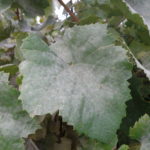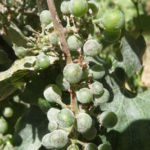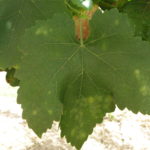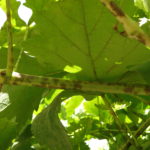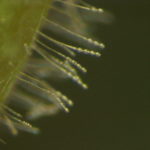.
Condición fitosanitaria: Presente
Grupo de cultivos: Frutales
Especie hospedante: Vid (Vitis vinifera)
Rango de hospedantes: específico / estrecho
Etiología: Hongo. Biotrófico
Agente causal: Erysiphe necator Schwein. 1834
synonym: Uncinula necator (Schwein.) Burrill, 1892
Taxonomía: Eukaryota > Fungi > Dikarya > Ascomycota > Pezizomycotina > Leotiomycetes > Leotiomycetidae > Erysiphales > Erysiphaceae > Erysiphe
.
.
Antecedentes
El oídio de la vid es una de las principales enfermedades fúngicas del cultivo de vid en todo el mundo.
Aunque por lo general no causa directamente la muerte de la planta, las infecciones intensas pueden provocar grandes pérdidas de rendimiento, e incluso niveles bajos de la enfermedad pueden afectar negativamente la calidad del vino.
.
Síntomas y signos
.
- Signo del oídio de la vid. Autor: © Government of Western Australia
- Signo del oídio de la vid. Autor: © Government of Western Australia
- Síntomas de hambre de la planta causados por el oídio de la vid. Autor: © Government of Western Australia
- Síntomas causados por el oídio de la vid en entrenudos. Autor: © Government of Western Australia
- Conidios en conidióforos libres de Erysiphe necator. Autor: © Government of Western Australia
.
.
.
Bibliografía
Agurto M, Schlechter RO, Armijo G, et al. (2017) RUN1 and REN1 Pyramiding in Grapevine (Vitis vinifera cv. Crimson Seedless) Displays an Improved Defense Response Leading to Enhanced Resistance to Powdery Mildew (Erysiphe necator). Front. Plant Sci. 8: 758. doi: 10.3389/fpls.2017.00758
Bleyer K, Bleyer G, Schumacher S (2023) Using ontogenetic resistance of grapevine for fungicide reduction strategies. Eur J Plant Pathol 165: 115–124. doi: 10.1007/s10658-022-02592-w
Braun U (2012) The impacts of the discontinuation of dual nomenclature of pleomorphic fungi: the trivial facts, problems, and strategies. IMA Fungus 3: 81–86. doi: 10.5598/imafungus.2012.03.01.08
Braun U (2013) (2210–2232) Proposals to conserve the teleomorph–typified name Blumeria against the anamorph–typified name Oidium and twenty–two teleomorph–typified powdery mildew species names against competing anamorph–typified names (Ascomycota: Erysiphaceae). Taxon, 62: 1328-1331. doi: 10.12705/626.20
Calonnec A, Jolivet J, Ramaroson M, Dufour M‐C, Corio‐Costet M‐F (2021) Defence responses of grapevine cultivars to powdery mildew: ontogenic resistance vs genetic resistance. Plant Pathology 70: 1583-1600. doi: 10.1111/ppa.13404
Colcol JF, Baudoin AB (2016) Sensitivity of Erysiphe necator and Plasmopara viticola in Virginia to QoI Fungicides, Boscalid, Quinoxyfen, Thiophanate Methyl, and Mefenoxam. Plant Disease 100(2): 337-344. doi: 10.1094/PDIS-01-15-0012-RE
Gadoury DM, Cadle-Davidson L, Wilcox WF, et al. (2012) Grapevine powdery mildew (Erysiphe necator): a fascinating system for the study of the biology, ecology and epidemiology of an obligate biotroph. Molecular Plant Pathology 13: 1-16. doi: 10.1111/j.1364-3703.2011.00728.x
Heffer V, Johnson KB, Powelson ML, Shishkoff N (2006) Identification of Powdery Mildew Fungi anno 2006. The Plant Health Instructor. doi: 10.1094/PHI-I-2006-0706-01
Kunova A, Pizzatti C, Saracchi M, et al. (2021) Grapevine Powdery Mildew: Fungicides for Its Management and Advances in Molecular Detection of Markers Associated with Resistance. Microorganisms 9(7): 1541. doi: 10.3390/microorganisms9071541
Lowder SR, Neill TM, Peetz AB, et al. (2023) A Rapid Glove-Based Inoculum Sampling Technique to Monitor Erysiphe necator in Commercial Vineyards. Plant Dis. 107(10): 3096-3105. doi: 10.1094/PDIS-02-23-0216-RE
Németh MZ, Seress D, Nonomura T (2023) Fungi Parasitizing Powdery Mildew Fungi: Ampelomyces Strains as Biocontrol Agents against Powdery Mildews. Agronomy 13(8): 1991. doi: 10.3390/agronomy13081991
Qiu W, Feechan A, Dry I (2015) Current understanding of grapevine defense mechanisms against the biotrophic fungus (Erysiphe necator), the causal agent of powdery mildew disease. Horticulture Research 2: 15020. doi: 10.1038/hortres.2015.20
Rallos LEE (2012) Characterizing resistance of the grapevine powdery mildew Erysiphe necator to fungicides belonging to quinone outside inhibitors and demethylation inhibitors. PhD Thesis, Virginia Polytechnic Institute and State University. Link
Rossi V, Caffi T, Legler S (2010) Dynamics of ascospore maturation and discharge in Erysiphe necator, the causal agent of grape powdery mildew. Phytopathology 100: 1321-1329. doi: 10.1094/PHYTO-05-10-0149
Saha S, Thosar RU, Das D, Chavan V (2023) Strategic Management of Powdery Mildew of Grapes Using Fungicides and Bio-Control Agents. IJBSM [Internet] 14: 1028-1036. Link
Sheikholeslami M, Okhovvat SM, Hedjaroude GA, et al. (2005) Study on the overwintering of cleistothecia and conidia of Erysiphe betae causal agent of sugar beet powdery mildew in Iran. Commun Agric Appl Biol Sci. 70(3): 333-7.
Stergiopoulos I, Aoun N, van Huynh Q, et al. (2022) Identification of Putative SDHI Target Site Mutations in the SDHB, SDHC, and SDHD Subunits of the Grape Powdery Mildew Pathogen Erysiphe necator. Plant Dis. 106(9): 2310-2320. doi: 10.1094/PDIS-09-21-1993-RE
, (2024) Pre-infection efficacy of resistance inducers against grapevine powdery mildew. Plant Pathology 00: 1–9. doi: 10.1111/ppa.13886
Vielba-Fernández A, Polonio Á, Ruiz-Jiménez L, et al. (2020) Fungicide Resistance in Powdery Mildew Fungi. Microorganisms 8(9): 1431. doi: 10.3390/microorganisms8091431
